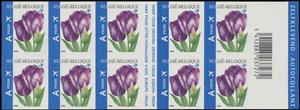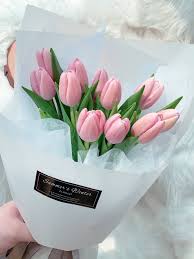Booklet Pane: Tulip Rembrandt Selfadhesive (Belgium 2006)
Tulip Rembrandt Selfadhesive (Belgium 2006)
07 August (Belgium ) within release Flowers goes into circulation Booklet Pane Tulip Rembrandt Selfadhesive face value 10*PRIOR No Face Value
| Booklet Pane Tulip Rembrandt Selfadhesive in catalogues | |
|---|---|
| Belgium: | Bel: BE B66ND |
Booklet Pane is square format.
Also in the issue Flowers:
- Booklet - Corn Flower Self-adhesive Booklet face value PRIOR;
- Booklet - Booklet Tulip Rembrandt Selfadhesive face value PRIOR;
- Stamp - Corn Flower Self-adhesive - left imperf face value PRIOR;
- Stamp - Corn Flower Self-adhesive - left + top imperf face value PRIOR;
- Stamp - Corn Flower Self-adhesive - left + bottom imperf face value PRIOR;
- Stamp - Rembrandt Tulip Self-adhesive - top imperf face value PRIOR;
- Stamp - Rembrandt Tulip Self-adhesive - bottom imperf face value PRIOR;
- Stamp - Rembrandt Tulip Self-adhesive - top + left imperf face value PRIOR;
- Stamp - Rembrandt Tulip Self-adhesive - bottom + left imperf face value PRIOR;
- Booklet Pane - Tulip Rembrandt Selfadhesive face value 10*PRIOR;
Booklet Pane Tulip Rembrandt Selfadhesive it reflects the thematic directions:
An aircraft (pl. aircraft) is a vehicle that is able to fly by gaining support from the air. It counters the force of gravity by using either static lift or the dynamic lift of an airfoil, or, in a few cases, direct downward thrust from its engines. Common examples of aircraft include airplanes, rotorcraft (including helicopters), airships (including blimps), gliders, paramotors, and hot air balloons.Part 1 (Definitions and Abbreviations) of Subchapter A of Chapter I of Title 14 of the U. S. Code of Federal Regulations states that aircraft "means a device that is used or intended to be used for flight in the air."
Aviation is the practical aspect or art of aeronautics, being the design, development, production, operation and use of aircraft, especially heavier than air aircraft. The word aviation was coined by French writer and former naval officer Gabriel La Landelle in 1863, from the verb avier (synonymous flying), itself derived from the Latin word avis ("bird") and the suffix -ation.
A flower, sometimes known as a bloom or blossom, is the reproductive structure found in plants that are floral (plants of the division Magnoliophyta, also called angiosperms). The biological function of a flower is to effect reproduction, usually by providing a mechanism for the union of sperm with eggs. Flowers may facilitate outcrossing (fusion of sperm and eggs from different individuals in a population) or allow selfing (fusion of sperm and egg from the same flower). Some flowers produce diaspores without fertilization (parthenocarpy). Flowers contain sporangia and are the site where gametophytes develop. Many flowers have evolved to be attractive to animals, so as to cause them to be vectors for the transfer of pollen. After fertilization, the ovary of the flower develops into fruit containing seeds. In addition to facilitating the reproduction of flowering plants, flowers have long been admired and used by humans to beautify their environment, and also as objects of romance, ritual, religion, medicine and as a source of food.
Flora is the plant life occurring in a particular region or time, generally the naturally occurring or indigenous—native plant life. The corresponding term for animal life is fauna. Flora, fauna and other forms of life such as fungi are collectively referred to as biota. Sometimes bacteria and fungi are also referred to as flora, as in the terms gut flora or skin flora.
Tulips are spring-blooming perennial herbaceous bulbiferous geophytes in the Tulipa genus. Their flowers are usually large, showy, and brightly coloured, generally red, orange, pink, yellow, or white. They often have a different coloured blotch at the base of the tepals, internally. Because of a degree of variability within the populations and a long history of cultivation, classification has been complex and controversial. The tulip is a member of the lily family, Liliaceae,along with 14 other genera, where it is most closely related to Amana, Erythronium, and Gagea in the tribe Lilieae.





